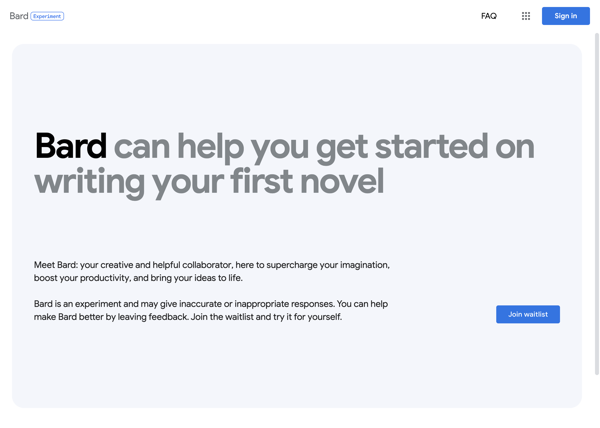
Table Of Content
- Introduction to Google's Bard: The Generative AI Experiment
- Understanding Bard: Collaboration and Productivity Enhanced by AI
- Bard's Foundation: The Role of Large Language Models in AI Assistance
- Generating Responses with Bard: How Quality and Efficiency are Achieved
- Streamlining Ideas and Fueling Curiosity with Bard
- The Benefits of Utilizing Bard for Content Creation and More
- Addressing Bard's Limitations: Inaccuracy and Bias Concerns
- Navigating Bard's Drafts: Choosing the Best Response for Your Needs
- Bard's Global Rollout: Access Availability and Future Prospects
- Conclusion: Weighing the Impact of Bard on Everyday Productivity
- Related AI Tools for Google-Bard (Ordered by relevancy)
- References:
Unleash the Power of AI and Transform Your Life Today! Click here to go to Google-Bard
Introduction to Google's Bard: The Generative AI Experiment
Have you ever imagined a world where an AI companion could brainstorm with you as though it was another human being? Google's Bard is an ambitious leap into this reality, forging a path for generative AI to contribute to human productivity and creativity in unprecedented ways. In this post, we delve into the capabilities of Bard, explore its foundations, and weigh the transformation it promises to bring to various sectors.
Here's a quick overview of the key takeaways from this article:
| Key Takeaways |
|---|
| Google’s Bard is a generative AI designed to augment human productivity and creativity. |
| Bard leverages advanced large language models to provide high-quality, efficient assistance. |
| It aids in generating ideas, responses, and content, aiming to streamline creative processes. |
| Bard is being rolled out globally, widening access and testing its potential across different demographics. |
| While promising, Bard faces challenges such as ensuring accuracy and avoiding bias. |
Understanding Bard: Collaboration and Productivity Enhanced by AI
In the fast-paced digital world, the ability to quickly synthesize information and generate new ideas is key. Bard, designed as a collaborative tool, helps to enhance these aspects of work. By processing vast amounts of data, Bard can offer suggestions, develop concepts, and even draft content, allowing professionals to accelerate their workflow.
Bard is not just a tool but a partner, designed to elevate our natural capabilities and complement our thought processes.
Bard's Foundation: The Role of Large Language Models in AI Assistance
Bard is underpinned by sophisticated large language models (LLMs), which are the result of extensive training on diverse datasets. These models understand context, generate relevant responses, and can even predict what users might need next. This ability stems from their deep learning foundations, enabling them to process language in a way that mimics human understanding.
Generating Responses with Bard: How Quality and Efficiency are Achieved
Every query to Bard is met with responses crafted through complex algorithms ensuring relevance and quality. Efficiency is achieved as Bard reduces the time spent on brainstorming and drafting, offering users a starting point that is often closer to the end goal than a blank page.
- Timeliness: Responses are generated in real-time.
- Relevance: Content is tailored to the context of the query.
- Quality: Bard strives to maintain a high standard in its textual output.
Streamlining Ideas and Fueling Curiosity with Bard
Creativity often needs a nudge, and Bard is designed to be that catalyst. Whether you're looking for a fresh perspective or trying to overcome writer's block, Bard can inject new life into your projects. It can help you:
- Explore various angles on a topic
- Suggest outlines for articles or reports
- Provide data-driven insights
The Benefits of Utilizing Bard for Content Creation and More
The potential benefits of integrating Bard into your workflow are manifold. Content creators can draft more efficiently, researchers can sift through information quicker, and teams can brainstorm without the usual logistical constraints. Bard also has applications in education, helping students to explore complex topics and fostering a deeper level of engagement.
Addressing Bard's Limitations: Inaccuracy and Bias Concerns
As with any AI system, Bard is not without its challenges. Inaccuracy and bias are significant concerns that Google continuously works to address. By refining algorithms and expanding training datasets, the aim is to minimize these issues and ensure Bard's outputs are as reliable and neutral as possible.
It's crucial to remain vigilant when using AI like Bard, and employ critical thinking to assess its outputs.
Navigating Bard's Drafts: Choosing the Best Response for Your Needs
Bard can offer multiple responses, but selecting the most suitable one requires human judgment. Factors to consider include:
- Alignment with the intended message
- Appropriateness for the target audience
- Quality and inclusivity of the content
Bard's Global Rollout: Access Availability and Future Prospects
Bard's global rollout introduces this innovative AI to a wider audience, testing its scalability and impact across different cultural contexts. As access to Bard expands, it will be fascinating to observe how various industries and communities adopt and adapt its capabilities.
Conclusion: Weighing the Impact of Bard on Everyday Productivity
The advent of Google's Bard is a significant milestone in the AI arena, promising to bolster productivity and spur creativity. While mindful of its limitations, the optimistic prospects of such technology could herald a new era of human-AI collaboration, enriching our world with ideas that were once out of reach.
Integrating Bard into one's workflow now could very well shape the way we approach tasks and solve problems in the future, making this an exciting time to embrace the potential of generative AI.

